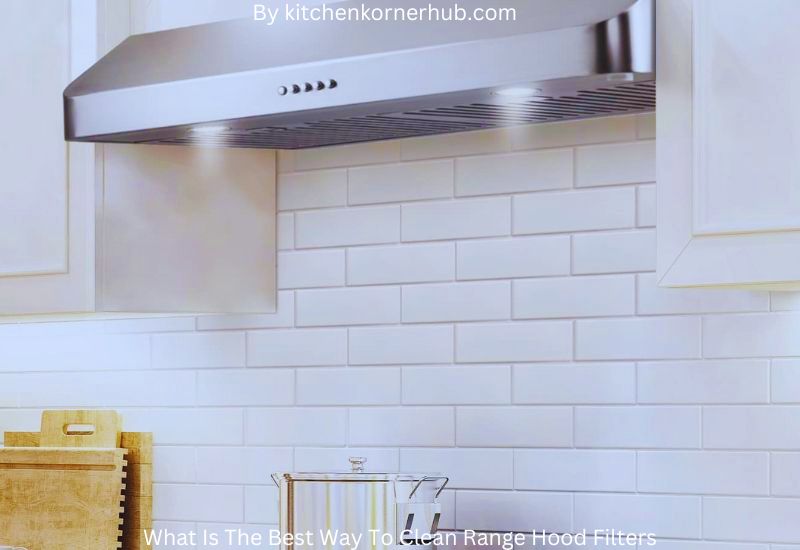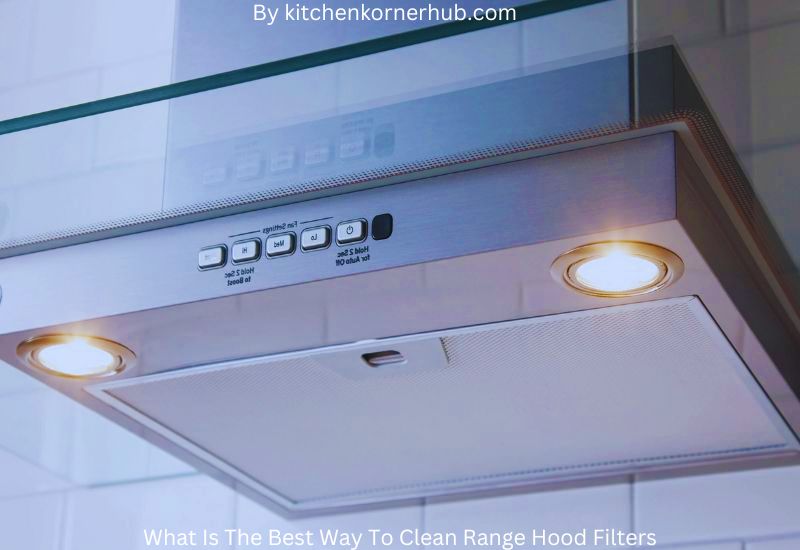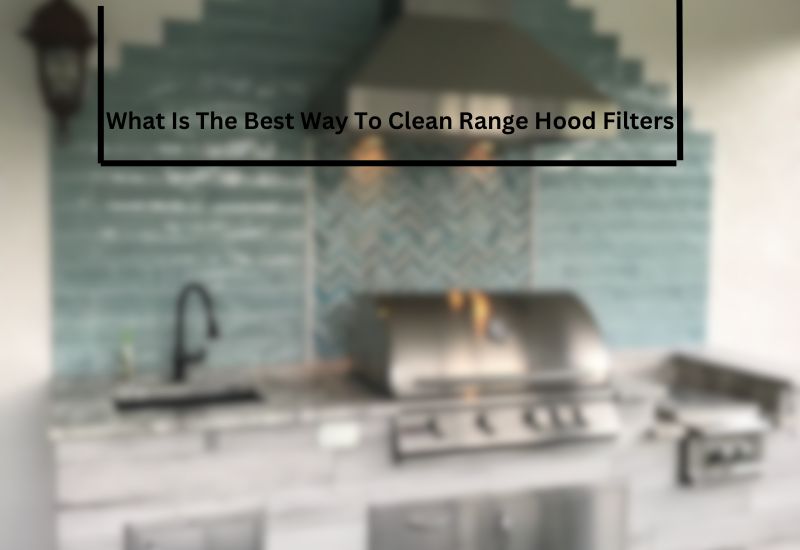Cleaning range hood filters is an essential task to maintain a healthy kitchen environment and efficient ventilation system. Range hood filters play a crucial role in trapping grease, smoke, and odors that accumulate while cooking. Over time, these filters can become clogged, affecting their performance and even posing a fire hazard.
What Is The Best Way To Clean Range Hood Filters? The most effective way to clean range hood filters is by soaking them in a mixture of hot water and degreasing dish soap for about 15-30 minutes. After soaking, scrub the filters gently with a brush, rinse thoroughly, and let them air dry before reattaching to the hood.
In this guide, we’ll explore the best way to clean range hood filters using simple methods that anyone can follow. From understanding the types of filters to using readily available household items, we’ll provide you with step-by-step instructions to keep your kitchen air clean and your range hood operating optimally.
By following these easy cleaning techniques, you can prolong the life of your range hood, reduce energy consumption, and create a healthier cooking environment for you and your family.
Understanding Range Hood Filters: Exploring the Importance of Clean Filters

When it comes to maintaining a clean and healthy kitchen environment, range hood filters play a vital role that often goes unnoticed. These filters are essential components of your kitchen’s ventilation system, designed to trap and remove grease, smoke, odors, and other airborne particles generated during cooking.
While they might seem inconspicuous, understanding the importance of clean range hood filters can significantly impact the quality of your indoor air and overall cooking experience.
The Function of Range Hood Filters:
Range hood filters serve as the first line of defense against grease and impurities that result from cooking processes. They capture particles released when you cook, preventing them from spreading throughout your kitchen and home.
Over time, these filters can become clogged and saturated with grease, which compromises their efficiency. When filters are not cleaned regularly, the ventilation system has to work harder to maintain proper airflow, leading to reduced effectiveness in removing pollutants and potentially higher energy consumption.
Indoor Air Quality and Health:
One of the primary reasons to maintain clean range hood filters is to preserve indoor air quality. Cooking activities release various pollutants such as volatile organic compounds, carbon monoxide, and fine particles into the air.
These pollutants can contribute to respiratory issues and allergies, particularly in those with sensitivities. Clean filters effectively trap these pollutants, preventing them from recirculating and improving the air you and your family breathe. Regular filter maintenance is especially crucial if someone in your household has respiratory conditions.
Fire Safety Considerations:
Grease buildup on range hood filters can pose a fire hazard. Grease is highly flammable, and if it accumulates within the filter and ventilation system, it increases the risk of a kitchen fire.
A clean filter reduces the chances of grease ignition and helps ensure safer cooking practices. Regular cleaning and maintenance of range hood filters can significantly mitigate this potential danger and provide peace of mind while cooking.
Energy Efficiency and Cost Savings:
Clean range hood filters can also contribute to energy efficiency in your kitchen. When filters are clogged with grease and debris, the ventilation system has to work harder to pull air through, leading to increased energy consumption.
By regularly cleaning or replacing filters, you can help maintain optimal airflow, reducing the strain on your ventilation system and potentially lowering energy bills in the process.
Prolonging the Life of Your Range Hood:
Neglecting filter maintenance can have a detrimental impact on the lifespan of your range hood. As filters become clogged, the motor and other components of the ventilation system are put under increased stress.
This can lead to premature wear and tear, resulting in the need for costly repairs or even replacement. By prioritizing regular filter cleaning, you can extend the life of your range hood and ensure its continued efficient operation.
Gather Your Supplies: Essential Tools for Effective Range Hood Filter Cleaning

Maintaining a clean and efficient kitchen environment is essential for both the longevity of your appliances and the quality of the air you breathe. One often overlooked yet crucial aspect of kitchen maintenance is the regular cleaning of range hood filters.
These filters play a vital role in trapping grease, smoke, and odors, preventing them from circulating back into your kitchen. To ensure the effectiveness of this filtration process, it’s imperative to have the right tools at your disposal. Here’s a comprehensive guide on the essential tools you’ll need for effective range hood filter cleaning.
Safety First: Protective Gear
Before delving into the cleaning process, prioritize safety by donning appropriate protective gear. Nitrile gloves will shield your hands from grease and cleaning agents, while safety goggles protect your eyes from any splatters.
Moreover, wearing an apron or old clothing will prevent your attire from getting stained during the cleaning process.
Degreasing Agents and Cleaning Solutions
Effective degreasing is key to restoring the filter’s optimal performance. Ensure you have a degreasing agent or a specialized cleaning solution suitable for your range hood filter.
Biodegradable, non-toxic solutions are ideal, as they’re effective in breaking down stubborn grease buildup without posing harm to the environment or your health.
Brushes and Scrubbing Tools
Removing stubborn grime and grease requires mechanical agitation. A set of brushes and scrubbing tools will be your allies in this battle against buildup.
Soft-bristle brushes and toothbrushes are perfect for delicate parts of the filter, while stiffer brushes can tackle more resistant dirt. Look for brushes with ergonomic handles for comfortable and efficient cleaning.
Sink or Bucket for Soaking
Depending on the type of filter you have, soaking it in warm, soapy water or a cleaning solution might be necessary. Ensure you have a sink or a bucket large enough to accommodate the filter.
This soaking process helps to loosen and break down the grease and grime, making the subsequent cleaning easier and more effective.
Microfiber Cloths and Towels
Once you’ve cleaned and rinsed the filter, it’s important to dry it thoroughly before reinstalling it. Microfiber cloths and towels are excellent for this purpose, as they absorb water efficiently and won’t leave lint behind.
Drying the filter completely prevents moisture buildup that could lead to mold or bacterial growth.
Preparation and Safety Measures: Getting Ready to Clean Your Range Hood Filters

Maintaining a clean and functional kitchen is essential for both the hygiene of your space and the longevity of your appliances. One often overlooked yet crucial component is the range hood filter.
Regular cleaning of these filters not only ensures efficient ventilation but also prevents the accumulation of grease and debris that could pose fire hazards. Before you dive into the cleaning process, it’s important to follow some preparation and safety measures to ensure a smooth and risk-free experience.
Gathering Your Supplies
Before you start the cleaning process, gather all the necessary supplies. You’ll need a pair of gloves to protect your hands from grease and dirt, a sturdy step stool or ladder to reach the filter, warm water, mild dish soap, a soft-bristle brush or sponge, and a clean, lint-free cloth for drying.
Having all your supplies within reach will make the cleaning process more efficient and less time-consuming.
Switching Off and Disconnecting
Your safety is paramount. Begin by turning off the range hood and unplugging it from the power source. This eliminates the risk of electrical shocks while handling the appliance and its parts.
Wait for the range hood to cool down if it has been used recently, as cleaning hot surfaces can cause burns. It’s also wise to don an apron or old clothes to protect your clothing from splatters and stains during the cleaning process.
Filter Removal
Removing the filters might differ depending on the type of range hood you have. Some filters easily slide out, while others might require removing a few screws.
Consult your range hood’s manual to understand the specific process for your model. Carefully follow the instructions to avoid damaging the filters or the hood itself.
Ventilation and Cleaning Area
Cleaning range hood filters can be a messy task due to the accumulated grease and dirt. To prevent further mess in your kitchen, choose a well-ventilated area, preferably outdoors if possible. Lay down old newspapers or a drop cloth to catch any drips or debris that might fall during the cleaning process
. This will make your cleanup job much easier once you’re done.
Safety Precautions
In the interest of safety, always handle the filters with care. Grease buildup can make them slippery, so take caution while holding them to prevent any accidental drops. When using water and soap for cleaning, ensure that water doesn’t enter the electrical components of the range hood.
Take care not to scrub too vigorously, as excessive pressure could damage the filters.
Step-by-Step Cleaning Guide: A Detailed Walkthrough of the Best Cleaning Process

Maintaining a clean and organized living space not only enhances the aesthetic appeal but also promotes a healthier and more productive environment.
Whether you’re a cleaning novice or looking to refine your cleaning routine, this step-by-step guide will provide you with a comprehensive walkthrough of the best cleaning process.
Gather Your Supplies:
Before diving into the cleaning process, assemble all the necessary cleaning supplies. This includes a variety of cleaning agents, microfiber cloths, sponges, a mop, a vacuum cleaner, a broom, and any specialized tools you might need for specific tasks.
Having everything on hand will save you time and prevent unnecessary interruptions during the cleaning process.
Declutter and Organize:
Start by decluttering the space you intend to clean. Clear away any items that are out of place or unnecessary clutter. This step not only makes cleaning easier but also gives you a chance to organize your belongings.
Sort items into categories and decide whether to keep, donate, or discard them. A clutter-free environment not only looks better but also makes daily maintenance simpler.
Room-by-Room Cleaning:
Break down your cleaning process by tackling one room at a time. Begin with dusting surfaces from top to bottom—start with ceiling fans, light fixtures, and shelves, then work your way down to tables, countertops, and other surfaces. Remember to use different cloths for different surfaces to prevent cross-contamination.
Next, focus on wiping down and sanitizing surfaces using appropriate cleaning agents. Don’t forget to clean overlooked areas like doorknobs, switch plates, and remote controls. Vacuum or sweep the floors before mopping for a thorough clean.
Deep Cleaning Tasks:
Periodically, incorporate deep cleaning tasks to maintain a truly pristine environment. Rotate these tasks on a weekly or monthly basis. Deep cleaning might involve tasks such as washing windows, cleaning behind appliances, dusting blinds, vacuuming upholstery, and cleaning out rarely accessed areas like closets and storage spaces.
This approach prevents dirt and grime buildup over time, contributing to a consistently clean living space.
Regular Maintenance:
Once your space is spotless, establish a routine for regular maintenance. Daily tasks like making the bed, doing the dishes, and a quick tidy-up can prevent clutter from accumulating. Set aside specific times for cleaning, such as a weekly or bi-weekly cleaning session, and stick to your schedule.
This proactive approach ensures that your living space remains inviting and clean with minimal effort.
Conclusion
In conclusion, maintaining clean range hood filters is vital for a healthy and efficient kitchen environment. After evaluating various methods, it is evident that a combination of regular degreasing, soaking in a mixture of hot water and dish soap, and occasional baking soda or vinegar treatment proves to be the most effective approach. This approach not only eliminates grease and buildup effectively but also extends the lifespan of the filters. Remember, consistent cleaning not only enhances air quality but also ensures optimal performance of the range hood, making it an essential practice for any conscientious homeowner or cook.
Frequently Asked Question(What Is The Best Way To Clean Range Hood Filters)
How do I clean range hood filters?
Cleaning range hood filters is an essential part of kitchen maintenance. To clean them effectively, start by removing the filters from the hood. Check the manufacturer’s guidelines to ensure you’re handling them correctly. Most filters can be cleaned in your dishwasher, using the normal or heavy-duty cycle.
Alternatively, you can soak the filters in a mixture of hot water and a degreasing dish soap for about 10-15 minutes to loosen the grime. Use a soft brush or a non-abrasive sponge to gently scrub away remaining grease and dirt. Rinse the filters thoroughly and let them dry completely before reinserting them into the hood.
What is the best cleaner for rangehood filters?
When it comes to selecting the best cleaner for range hood filters, opt for a degreasing solution. A mixture of hot water and a grease-cutting dish soap works well for many filters. Another option is to use a baking soda paste by combining baking soda with water until it forms a thick consistency.
Apply the paste to the filters and let it sit for a while before scrubbing and rinsing. Commercial degreasing sprays specifically designed for kitchen appliances can also be effective. Always ensure to rinse the filters thoroughly and let them dry completely before reinstallation.
How do you clean a metal mesh cooker hood filter?
Cleaning a metal mesh cooker hood filter is similar to cleaning other types of range hood filters. Remove the filter from the hood and follow the manufacturer’s instructions. Start by soaking the filter in a mixture of hot water and a degreasing dish soap.
You can also use a solution of water and vinegar for added effectiveness. Gently scrub the filter with a soft brush or non-abrasive sponge to remove the accumulated grease and grime. Rinse the filter thoroughly and allow it to dry completely before placing it back in the cooker hood.
Can you clean hood vent filter?
Yes, you can clean a hood vent filter. The process involves removing the filter from the hood, whether it’s made of metal, charcoal, or other materials. Most hood vent filters can be cleaned using a mixture of hot water and a degreasing dish soap.
Soak the filter, scrub it gently with a soft brush or sponge, and rinse thoroughly. For metal filters, you can also use a baking soda paste or a water and vinegar solution. After cleaning, make sure the filter is completely dry before reattaching it to the hood to maintain proper ventilation efficiency.
What is a good homemade degreaser?
A good homemade degreaser can be easily made using simple household ingredients. One effective recipe involves mixing equal parts of white vinegar and water in a spray bottle. White vinegar is known for its grease-cutting properties and can help break down and remove grease and grime from various surfaces, including kitchen countertops, stovetops, and appliances. You can also add a few drops of dish soap to this mixture for added cleaning power.
Shake the bottle well to mix the ingredients thoroughly, and then spray it onto the greasy surface. Allow it to sit for a few minutes before wiping it away with a clean cloth or sponge. This homemade degreaser is both cost-effective and environmentally friendly.
What does baking soda do in a filter?
Baking soda serves as a helpful additive in various filtration systems, such as air purifiers and water filters, due to its ability to neutralize odors and improve filtration efficiency. In a filter, baking soda primarily functions as an odor absorber. It can effectively trap and neutralize unpleasant odors that may be present in the air or water passing through the filter.
This is particularly useful in air purifiers, where baking soda can help eliminate cooking smells, pet odors, and other unwanted scents. Baking soda can also improve the taste of water by reducing the presence of chlorine and other impurities, making it a popular addition to some water filtration systems. Overall, baking soda plays a role in enhancing the performance of filters by making the air or water cleaner and more pleasant to use or breathe.




